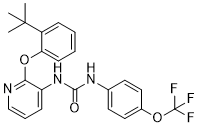This product is for research use only, not for human use. We do not sell to patients.

| Size | Price | Stock |
|---|---|---|
| 250mg | $900 | Check With Us |
| 500mg | $1450 | Check With Us |
| 1g | $2175 | Check With Us |
Cat #: V3526 CAS #: 870544-59-5 Purity ≥ 98%
Description: BPTU (BMS-646786), a non-nucleotide structure, is a new P2Y1 antagonist which has recently been described using X-ray crystallography as the first allosteric G-protein-coupled receptor antagonist located entirely outside of the helical bundle.
Publications Citing InvivoChem Products
Product Promise

- Physicochemical and Storage Information
- Protocol
- Related Biological Data
- Stock Solution Preparation
- Quality Control Documentation
| Molecular Weight (MW) | 445.43 |
|---|---|
| Molecular Formula | C23H22F3N3O3 |
| CAS No. | 870544-59-5 |
| Storage | -20℃ for 3 years in powder formr |
| -80℃ for 2 years in solvent |
| Protocol | In Vivo | Uptake of BPTU from the peritoneal cavity is relatively rapid. Blood boron levels are maximal within 1 h after administration. After only 1 h, a boron tumor-to-blood ratio above 1 is found for BPTU in pigmented tumors, which is indicative of drug retention. This is not seen in the non-pigmented tumor variant, in which tumor boron levels closely follow blood levels. Up to 24 h, Borocaptate sodium (BSH) exhibits no selective retention in either tumor, but achieves higher maximum tumor boron concentrations than BPTU as a result of the administration of higher amounts of boron. During the tissue distribution phase, liver-to-kidney boron concentration ratios range from 2 to 4 for BSH and from 0.5 to 1 for BPTU |
|---|
| Solvent volume to be added | Mass (the weight of a compound) | |||
|---|---|---|---|---|
| Mother liquor concentration | 1mg | 5mg | 10mg | 20mg |
| 1mM | 2.2450 mL | 11.2251 mL | 22.4502 mL | 44.9004 mL |
| 5mM | 0.4490 mL | 2.2450 mL | 4.4900 mL | 8.9801 mL |
| 10mM | 0.2245 mL | 1.1225 mL | 2.2450 mL | 4.4900 mL |
| 20mM | 0.1123 mL | 0.5613 mL | 1.1225 mL | 2.2450 mL |
This equation is commonly abbreviated as: C1 V1 = C2 V2
- (1) Please be sure that the solution is clear before the addition of next solvent. Dissolution methods like vortex, ultrasound or warming and heat may be used to aid dissolving.
- (2) Be sure to add the solvent(s) in order.




































